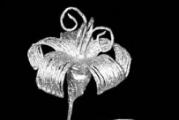Foil weaving step by step instructions. A fashionable fascinating activity is foil weaving. What can be made from foil
I noticed new sets in handicraft stores - do-it-yourself foil weaving. I looked, turned it over, it's very simple.
No glue needed. Cut the foil into strips 3 cm wide and the length of the roll. The foil needs to be thin, suitable for food packaging, the one that is thicker for baking is not suitable. Then you need to crush the strip across its entire length and twist it, as when spinning. It turns out a shiny wire 2-3 mm in diameter. Anything is woven from such wires, by screwing the wires to each other.

Colored foil is suitable only double-sided, otherwise, when twisted, the silver color crawls out and the craft looks sloppy.


Here's what you can do - DIY foil weaving. By the way, it suits very well as an addition to a gift.
I propose to consider the MK of a grape branch

You will need: foil, scissors, paper napkins, a ruler, patience and a good mood.

We cut the foil across the sheet into strips 3 cm wide each. We will use these strips to weave the leaves. A total of 21 strips are required.

We crush the strips with our fingertips, first form thick bundles, which we then gently roll into flexible shiny wires.

For weaving leaves, we need:
1) wires of standard length (i.e. obtained by cutting off the roll along its width, our standard wire is 17 cm long) - 14 pieces,
2) double-length wires (34 cm) - 2 pieces,
3) wires of triple length (51 cm) - 1 piece.
Double or triple length can be obtained in two ways:
1) We connect two or three original strips before the creasing process, after which we form a common wire. We start the creasing process from the junction.
2) Cut off strips of foil to the desired length at once, cutting the roll along. With this method, the joints will definitely not be visible, but the consumption of foil is less economical.

We form a five-fingered leaf. We need 1 triple wire and 7 standard wires.
We bend the long wire in half, fasten the standard wire to the bend with a double tight turn.

By bending the long wire, we give it the shape of a five-fingered leaf.

Next, we form the veins on the sheet. For this we need the remaining standard wires. With a double helix we fix the wire on the upper "cavity" of the sheet and, passing through the middle of the central vein, we also fix it with a double helix on the symmetrical cavity. We cut off the excess - these segments are useful for small veins.

In the same way, add three more veins, connecting symmetrical leaf depressions and pointed areas. All veins must be in contact in the center, so that we can then twist them together. It turned out something like this.



We attach small veins on each pointed section of the sheet. To do this, we fix the wire with a double helix on the outer contour of the sheet, with a single turn we pass it through the corresponding vein and symmetrically fix it with a double helix on another outer contour. We make 5 such veins.

Formation of a three-toed leaf. I must say right away that we liked doing the three-fingered leaf more - faster, more convenient, the leaf is more rigid and holds its shape better.
You will need 1 double-length wire and 6 standard wires.
The beginning is the same - with a double helix we fasten a small wire to the fold of a long wire.
13.
.
We form a three-toed form. We immediately tie the lower ends into the petiole.


Something like this.


We add the veins in the same way as the five-fingered sheet (see paragraph 12). Sharpen the tips of the sheet by pressing your fingers.

To make the antennae, take the remaining double-length wire and wind it around a pencil. Remove and stretch.

We got it like this.

Next, we will make the grapes ourselves.
We cut the foil across the width of the sheet into strips of greater width (we got strips 7-8 cm wide and 17 cm long).
We twist flexible wires from two strips - then we will form a bunch on their basis.
The remaining strips are cut across into two equal parts - from which we will make grapes.
The instructions suggest twisting 40 berries, we made a little less.

To create berries, use paper napkins, cut in half. Crumple the napkins, preferably with slightly damp hands, then roll tight balls between the palms.

Take half a wide strip of foil and wrap the end of the paper ball tightly. Crumple the free end of the foil and twist it into a wire, as for leaves. Thus, we make as many grapes as we need.

We form the bunch itself. Take one of the two wires for the base of the bunch (see paragraph 21). We fasten two grapes sequentially to its edge.
Using the same technique, we twist three berries together, screwing the other two to one stalk.

It turned out like this.

We fasten the second base wire with a double spiral below. We will also fasten grape blanks to it. Then we form a bunch to our taste.
We fasten the leaves and antennae to the upper, berry-free part.

We admire the result.
The idea, of course, is not ours, but I think it will be useful to many. We wish you all creative success !!!
From here: stranamasterov.ru
Nadezhda Prosyannikova
Today I want to introduce you how you can make a very beautiful and elegant decoration for the holiday.
"Foilart", or weaving from foil, - a new kind of needlework invented by Olesya Emelyanova. This is a simple and very exciting activity that allows you to create original jewelry with your own hands. Material preparation process - twisting a wire from a strip foil... Weave from foil just, fascinatingly. Aluminum foil soft and completely safe material. It is easy and pleasant to work with it; no special skills or special tools are required. It is economical and within the power of everyone.
What do we need for this will need:
1. Roll food foil,
3. Ruler,
4. Scissors,
5. Paper napkins
7. Air balloon.
Working process:
Draw with a blunt pencil foil on strips 3 cmand then carefully cut along the lines.

Twist a wire from each strip. To do this, crush the strips across the entire length until it becomes 4-5 mm thick.

Cut each in half

Put the seven halves tightly side by side and twist the ends into a flagellum. Bend the wires into an oval shape. Weave five of these petals.

Wrap the napkin ball tightly with the end of the strip. Crumple the free end of the strip across and roll it up like a wire.

For one flower, we need three stamens.

Place five petals around the stamens and thread the petals to the stem with a thread.

Inflate the balloon, wrap it with a thread, when the glue dries, blow off the balloon and pull it out. This is the basis for our decoration.
Now, in a chaotic manner, insert our lilies all over the ball.


All our decoration is ready. It looks very nice and elegant.
Thanks to everyone who looked at my page, I wish everyone creative success and good mood.
Related publications:
Good evening, dear colleagues, tomorrow is the first spring holiday - March 8. In kindergarten, everyone prepared for matinees, prepared gifts for.
For children of the preparatory group. Purpose: to continue to acquaint children with the bas-relief method of modeling; enrich working techniques (use.
Master class "Flowers from foil". For children of the preparatory group. On the eve of the New Year, I really wanted something unusual and magical.
The educator of the second group of early age: Neklyudova Darina Sergeevna The purpose of the master class: Formation of the skills of teachers to create a product.
Relevance. The development of the creative abilities of preschoolers is given special importance in the context of the standardization of preschool education.
At the end of November, our whole country celebrates the tender holiday of Mother's Day. In MDOU VMR "Kindergarten № 30" Fairy Tale "has become kind for several years.
Master class "Lilies in a vase" Purpose: interior decoration. Purpose: creating crafts using an unconventional material - threads.
Elena Shvetsova
Ice flower. Foil weaving workshop.
Dear colleagues!
I am pleased to present to you master Class« Ice flower» by foil weaving.
For work you will need foilSayanskaya and scissors.

Foil beautiful in itself, shiny, but not very durable. Therefore, we will begin work with the manufacture of aluminum "Straws".
Take scissors and cut 20-30 strips from a roll by eye foil 2-3 cm wide each. To the foil did not tear, make long cuts (over the entire length of the blade, and after each, spread the tips of the scissors wide apart. Try to avoid burrs and cuts on the edge of the strip. They may tear the strip when twisted. Also, do not try to fold foil before cutting into several layers, otherwise you will not be able to separate the cut strips without tearing from each other.
Now take one strip and, with grasping movements of both hands, ruthlessly fold it across the entire length.
Pinch "Sausage" between the thumb and forefinger of both hands, and, as it were, "Spin" her, slowly moving from beginning to end. If there are irregularities, then walk over them again.
For elasticity and strength flower put in each strip foil thin copper wire.

Secure the straw in the middle of the other straw with a double twist, press the twist firmly with your fingers.



Secure five straws on the sixth double twist, close together.

Twist all the ends of the straws together at the base of the petal.

The petal is ready!
There can be from three to five or six such petals, at your request.

Now let's make the middle flower.
On a rectangular piece foil put a wad of napkin or a ball of foil, hide it inside and twist the core a flower with a stem.

Inside the future stem, you can put steel wire or a plastic frame from artificial flowers.

Now wind the pieces of straws on the pencil, these will be stamens flower.

Gather all the parts together with a wire.


The flower is ready!


Leaflets for flower do it in the simplest way - fold six straws together and twist with a simple twist at the beginning and end.

If you are fully involved in the creative process, "spinning" aluminum straw began to bring you joy and does not interfere with watching your favorite TV shows, do flower simplifiedwhere the petals are composed of aluminum straws from smallest to largest.

For the patient, creative nature of variations weaving flowers from foil a huge variety!



Enjoy your creative process!
Thanks to everyone who looked at my page!
Related publications:
I suggest making your own Christmas decoration a flashlight. It will turn out to be especially beautiful, shiny, since we will make it from self-adhesive.
“Silver miracle. FOILART ". Foil weaving workshop. Dear colleagues! Today, based on our preschool.
Recently, on our favorite site, I saw foil crafts. They were unusual, graceful and easy to perform. I decided to try it. It turned out.
I bring to your attention a master class on making foil baskets. For this we only need foil and scissors. Cut off.
Master class "New Year's bells" I present to you a master class on making New Year's bells, this craft was done together.
Greetings to everyone who has visited my page! Friends, today I want to introduce you to the foil candlestick master class. I took an ordinary one.
"FOILART" or weaving made of soft aluminum foil is a new type of needlework invented, developed and patented by me, Olesya Emelyanova (RF patent No. 2402426). This is a simple and exciting activity for girls and their mothers from 8 years old and older, which allows you to create original gifts and decorations for the interior with your own hands.
Aluminum foil is a soft, natural and completely safe material. It is easy and pleasant to work with him. Foil properties such as thermal and moisture resistance significantly expand the scope of decorative products made from it. New design horizons are opening up for you - with ready-made compositions you can decorate lamps, candlesticks, flower pots, verandas, gazebos, open loggias, kitchen and bathroom interiors. Wherever other jewelry quickly deteriorates or is dangerous, foil products continue to delight you with their beauty.
You don't need any special skills or the purchase of special tools. This hobby is extremely economical and everyone can do it. First, the foil is cut into strips and rolled into thin flexible wires. Their irregular glossy surface creates a beautiful decorative effect, which makes the products look like jewelry. Weaving techniques are simple, but they allow you to model any shape and give unlimited scope for creativity and self-expression. Follow the instructions and great results are guaranteed.
Foil is traditionally used in food preparation, especially meat and fish, as well as packaging for various products.
Foil braiding as an art
But creative personalities have found another application for it, namely in children's (and not only) crafts. This kind of art is called foil weaving.
This activity is very exciting, but it requires increased accuracy, since the foil breaks very easily.
Works of art made of foil will be a wonderful decoration for your home, a gift or decoration for different holidays. Such crafts from afar can be mistaken for silver figurines.
What can be made from foil
They turn out beautiful for the New Year, for example, snowflakes, snowmen, All this will give your home a festive atmosphere. In addition, you can weave anything and what your imagination is enough for: berries and fruits, flowers, animals and even people. You can make up whole compositions.
Before you start weaving, you can purchase a special weaving kit, which includes detailed instructions, foil, and a cardboard ruler. However, if it is not possible to get such a set, you can use the tips given here. They are all very simple, and you should have no difficulty in mastering foil weaving. The instructions will help you with this.
If you have ever tried knitting or embroidering, you will quickly grasp the principle and understand how to weave from foil with your own hands. And after a few tries, when you get your hands on it, you can create more complex and larger crafts.
Subtleties in weaving with foil
- Do not use heat-resistant or very thick foil. It will be hard work, your fingers will get tired quickly, and the products will be too stiff.
- Use long scissors with straight blades. Open the scissors wide to avoid breaking the foil and creating bumps. If you are creating with a child, make notes with a pencil and ruler before cutting the strips.
- The width of a standard roll of foil is 30 centimeters. Build on this by determining the length you need.
- The most important thing is to learn how to weave flagella. To do this, simply crumple the cut-out strip of foil lengthwise. Continue to squeeze it with your fingers until you get a piece with a diameter of 4-5 mm. Squeeze the flagellum with two fingers and start rolling it, slowly walking along its entire length. As a result, a wire 1.5-2 mm thick should form.
- The twisting of such flagella is a mechanical exercise, so your attention is not required. Weave a few of these tubes while watching a movie or telephone conversation. And then you just have to twist them, following the instructions.
- Fix all parts with the same number of scrolls so that the symmetry of the object is not broken.
- If you are weaving with your child, select craft patterns according to the child's age so that it is not too difficult or easy for him.
And now, using an example, we will analyze how to make some foil crafts for the New Year. Let's start with a beautiful and original candlestick.
Materials for making
Prepare the following materials and tools for work:
- regular food foil;
- scissors;
- a candle for which, in fact, you will make a candlestick;
- tape centimeter;
- medium-sized tin cover.
Making a New Year's candlestick together
When everything you need is ready, you can start weaving from foil.
- Take a lid, its diameter should be slightly larger than the diameter of the candle. Wrap the lid with foil.
- Measure a strip on the foil that is 10 centimeters wide and about 5 centimeters longer than the circumference of the base of the candlestick. Cut out the resulting strip.
- Roll this strip of foil into a thin, tight tube, like a flagellum, and connect the ends to form a ring. Tighten the connection well.
- Cut 5 more strips of this width. The length depends on the height of the candle you have chosen. For example, 50-60 centimeters.
- Twist the same tubes from the cut strips as before.
- Take one flagellum and attach it to the ring, twisting it in half so that a loop appears on the main ring.
- Do the same for the rest of the tubes. It turned out something like the sun.
- Connect all the flagella together, doing three twists each time. As a result, you should get a mesh.
- Place the ring in the lid.

That's all, your New Year's candlestick is ready.
What is required to weave snowflakes
Let's make another Christmas-themed decoration. And it will long ago become a kind of symbol of the main winter holidays. They are traditionally cut out of paper, cardboard, weaved from threads, made papier-mâché. All this can be replaced with foil weaving. The snowflake will be shiny and realistic enough. In addition, it will look harmoniously with the same candlestick and Christmas tree decorations.
You will need:
- scissors;
- plain foil;
- ruler.
How to weave a foil snowflake yourself
You can get to work.

The snowflake is ready. With the help of rings, you can hang it on the tree or anywhere else. And from a few snowflakes, you can build a whole garland.
There are other ways to make a foil snowflake. For example, such a cute snowflake, as shown in the figure below, is an alternative to the previous one, but here the design is performed without loop rings, but otherwise the procedure is the same.

As you can see, a very pleasant and interesting way to pass the time is foil weaving. The master class on the aforementioned products is simple and straightforward. With its help, even children can make such crafts.
How to decorate foil crafts
And with the help of weaving, you can make wonderful flower arrangements. It is not necessary that they be silver in color, the finished craft can be painted with acrylic paint, giving the desired shades to the resulting figures.
Either way, foil weaving ideas are endless, and there are probably new patterns and instructions for this fun activity every day.




